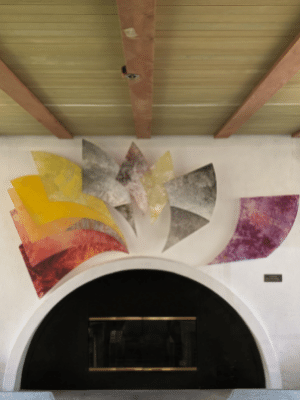
I imagine the ancient city of Alexandria. There is a tower in a certain district of the city where a philosopher / alchemist of renown lives and works. At the top of his tower is a square room that serves as his library and laboratory. The room is empty now and it is just after sundown. There is a residual sense of the philosopher’s presence, as he has recently vacated the room for a period of rest downstairs.
I carved wooden podium stands apart from the other furniture and equipment in the room. Lying open on the podium is a dusty venerable book, quite large in size. Through an open eastern-facing window on the left comes a warm evening breeze, catching the yellowed parchment pages, causing them to billow and flutter. The now-curving pages begin to lift away from the ancient book’s binding and they take flight across the room in a graceful dance.
--G Renfrow
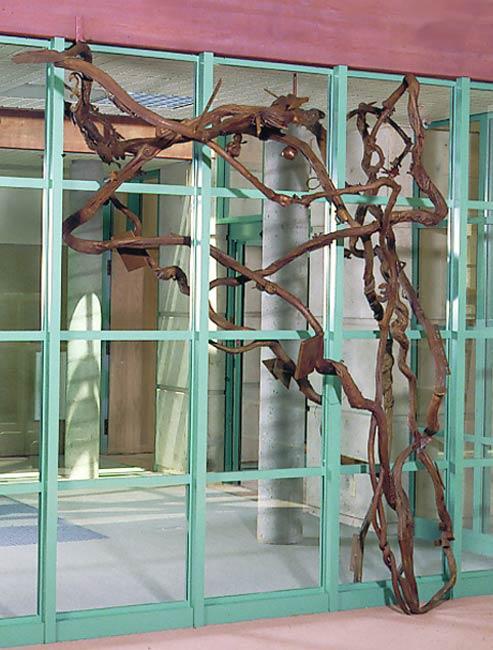
Dicta is a cast bronze and appropriated aluminum sculpture in the Benicia Public library. It symbolizes the juxtaposition of abstract, linear knowledge and cyclic, experiential knowledge.
Abstract, linear knowledge is represented by the aluminum grid that is the support for the glass wall that divides the main entry and circulation desk from the children's collection, as designed by the architect. It intersects a bronze organic form.
The cast bronze form represents cyclic, experiential knowledge. It was made by manipulating the wax positives from a mold taken from an old wisteria vine. The wax forms were re-shaped to create a closed form that loops back on itself. It interweaves the aluminum grid in six squares, where the glass panes are deleted.
The cast form has ancient and contemporary symbols of knowledge incised and modeled on it, such as hieroglyphs, vessels, snakes, apples, birds, letters, books, numbers, rulers, compasses, etc. The form is patinaed in a warm reddish brown with darker undertones and then buffed to reveal glints of bronze thereby highlighting the incised and modeled symbols. The bronze is then waxed. It is made to be touched.
Sandra Shannonhouse -- February 26, 1993
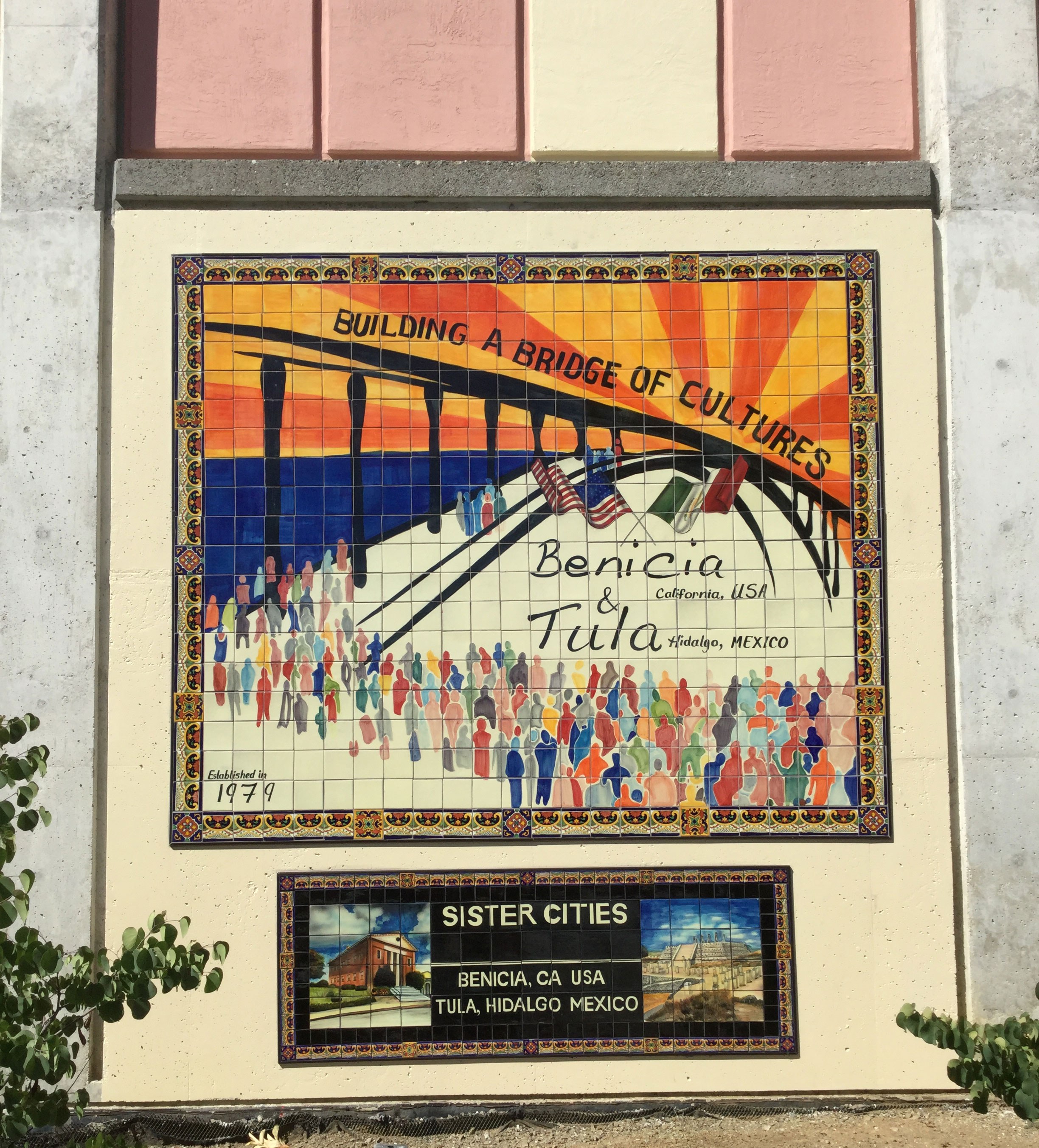
Sister Cities is a tile mural on the side of the library building facing the Bocce Courts, commemorating 40 years of the City's Sister City relationship with Tula, Mexico. It is made of hand-made tile.
July 3, 2019

Judy Chicago became involved in The Birth Project because she was interested in advancing embroidery as an art form and bringing it more to the attention of the general public. She is self-taught and has always considered her needlework as art. She particularly likes this image because it "expresses so much emotion and includes a man's feelings as well as a woman's." She has succeeded at make embroidery a recognized art form and has shown in many galleries and museums world wide.
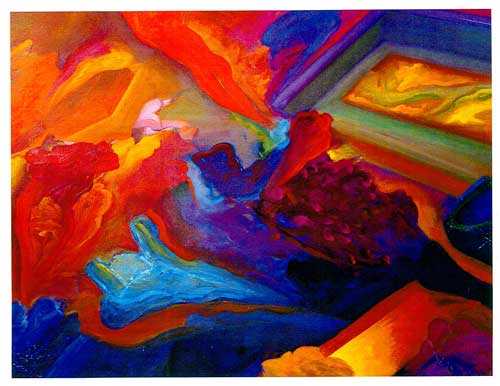
Julius Hatofsky was born in Ellenville, New York in 1922 to Russian immigrant parents. When he graduated from high school, he won a scholarship to the Art Students League in New York City but was unable to accept this honor because he needed to help support his family.
In 1942 Julius was drafted into World War II, s4rving in the 82nd Airborne in the Battle of the Bulge and invasions of Holland and Normandy, later liberating a concentration camp. “As I watched my fellow soldiers fall away from me in combat, I determined that if I survived, I would become a painter, but a painter on my own terms.”
When he returned from the war, he did attend the Art Students League from 1946 to 1950, spent a year in Paris at the Academie de la Grande Chaumiere and returned to New York to study at the Hans Hoffman School of Fine Art in 1952. From 1957, he exhibited work in galleries in New York City and Chicago and was included in the Whitney Annual of “New Talent” in 1959.
In 1962, he moved to San Francisco to become an instructor of Painting and Drawing at the San Francisco Art Institute until 1995 when he retired.
Julius moved to a 5,600 square foot loft south of Market in 1972 where he continued to paint and fashion unique inlaid tables and other furniture. He moved to Vallejo in 1999. Suffering from cancer, he found it difficult to climb the 30 stairs to the unheated loft that he loved. He lived seven more years, continuing to paint and challenge himself.
His last three exhibitions were large museum retrospectives. The show at the Triton Museum in Santa Clara closed the day he died on January 1, 2006.

It is difficult for me to define the nature of my paintings because I am wary of facile statements that sound lofty and profound, but say very little and make no visual connection with the work. To begin with, I’ve had two fine teachers, Morris Kantor and Robert Beverly Hale, who I studied with at the Arts Students’ League in New York form 1946-1950. I’ve also been influenced by many masters of the past such as Blake, Turner, Goya, Delacrois, Rodin and Tintoretto to name a few. Finally, certain crucial experiences in my life have affected my work deeply.
Inventing imagery is the basis of my paintings. Once involved, I concentrate on scale, inner light, drawing, surface, rhythm, color. Developing these painting concerns has helped to focus my emotional intensity and release my imagination.
At age 83, I have a range and variety of expression and imagery and feel a command over the work that has taken over 60 years to acquire. I constantly try to reach deeper, to move beyond my limitations, to challenge myself and to learn. I feel I’ve made considerable progress in the last twenty-five years.
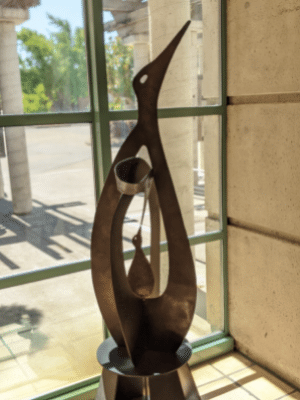
Hager’s sculpture “US,” is of a mother and fledgling penguin.
The artist was born and raised on her father’s 160-acre farm in Napa County, but as a second-generation Japanese American during World War II, her life changed dramatically when she, her mother and siblings were forced to uproot to Arizona to the Gila River Relocation Camp. In 1986, after her husband had died and she had taken a trip to Japan aboard a ship for 79 days, she decided to take art classes at Solano Community College. She took classes for the next 18 years and created over 25 metal sculptures in steel and copper.
Dedicated November 24, 1996.
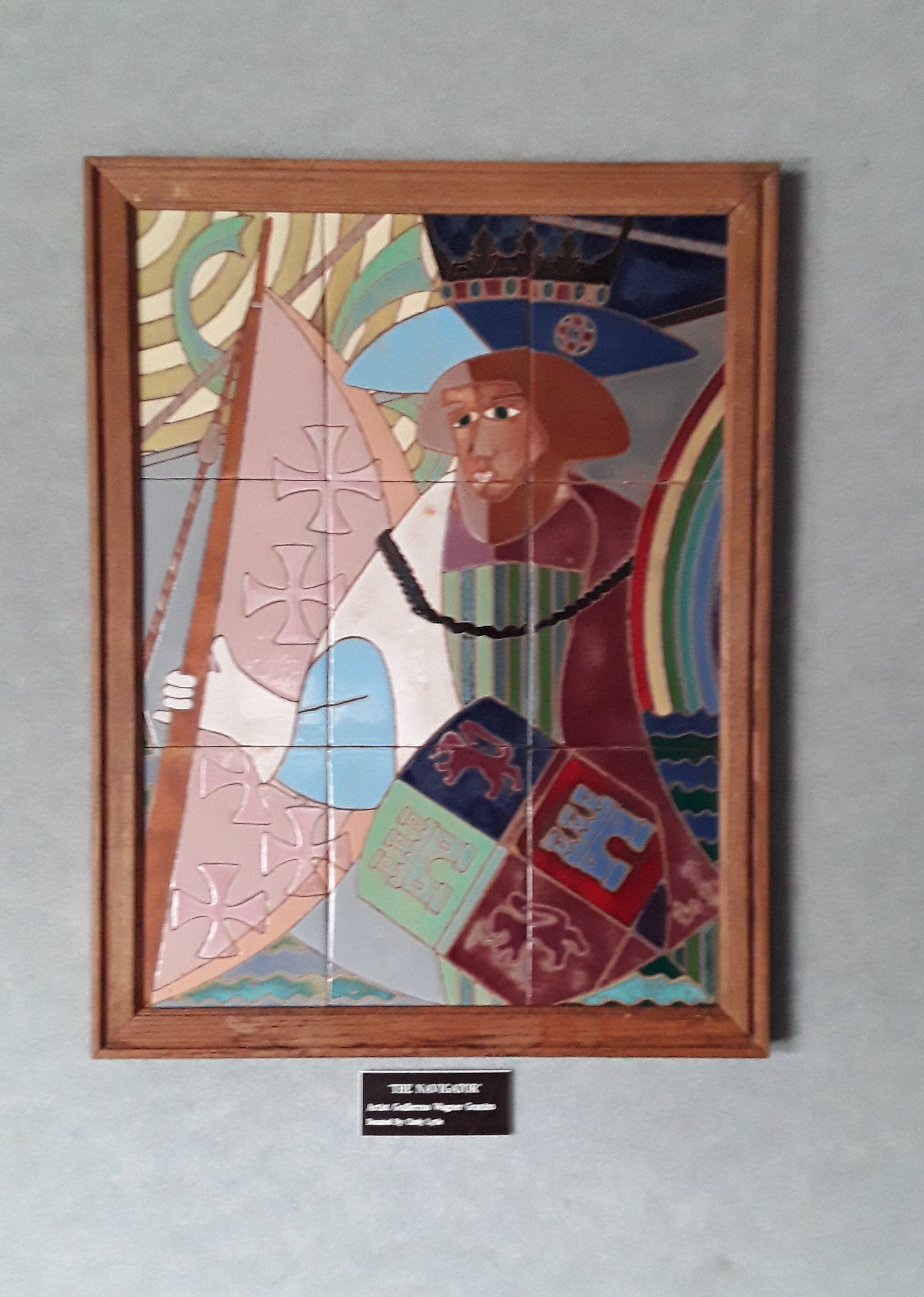
His works are expressed in colorful ceramic tiles, Guillermo Wagner Granizo, a celebrated ceramic muralist and internationally known artist worked out of his studio in Benicia for the last 20 years of his life. Guillermo ‘Bill” Wagner was born in San Francisco in 1923 and he traveled with his family to Nicaragua, Guatemala and Mexico. There he fell in love with ceramics. After World War II he graduated from the San Francisco Art Institute. The City of Benicia (formerly the state capital of California) became the center of his art.
Katrina Van Male was a Benicia resident who taught many children ceramics.
The main figure and all the small figurines are ceramic, hand-sculpted by the artist in stoneware clay. She then fired them in kilns: the small brown figurines clustered on top of the base were fired in a traditional wood-fire kiln, the other figurines were all hand-painted by the artist with iridescent paints after she fired them in gas and electric kilns. The wood-fired figurines are glazed only with natural wood ash from the kiln. The framework of the base is wood, which Katrina mosaiced in glass and ceramic, and hand-painted.
Katrina spent four years making lnori.
The wood-fire kiln Katrina used was one she had also helped build, in 1989. Spending labor-intensive months, a small group of artists dug a foundation and then laid brick and special kinds of mortar to build the 22-foot foot long kiln and 17-foot tall chimney. Firing a wood kiln is a community effort that includes gathering fallen wood, hauling it to the kiln, and chopping it into pieces the size of a person's forearm. Each firing consumes up to 8 cords of wood. A wood-fueled kiln must be tended every few minutes, twenty-four hours a day, for 4 to 8 days of firing. The kiln has to cool at least a week before it can be opened. The kiln was designed by Japanese master potter Mazakazu Kusakabe, and the build was supervised by sculptor and art professor Marc Lancet, who has taught wood-fired ceramics at Solano College since then. It remains one of the few publicly-available wood-fired kilns in the United States, and Katrina used it multiple times, firing alongside many other artists, including Lisa Jetonne, who later restored lnori at the request of Katrina's family for installation in the library.
The small figurines -- painted or wood-fired, in a niche, or on top of the base -- also have a separate name: jizo. In Japanese folklore, jizo are primarily protectors of children, of unborn babies, and of offspring who passed away before their parents. In Japan, jizo are often dressed in red or sometimes other colorful hues. They can take the form of a child, or a monk-like adult. Many of Katrina's jizo are children. Jizo are also said to protect travelers. Katrina often gave a jizo she had sculpted to friends when they were about to go on a trip.
The backstory dates to the 14th century: a Buddhist deity named Jizo declined enlightenment in order to spend an eternity shepherding children to a heavenly afterlife, smuggling them past danger by hiding them in his pockets, in the folds of his robe, and in the openings of his sleeves. Generous, kind, and ethical, he is also often held up for children in Japan as a role model of good conduct.
Millions of ceramic Jizo are found across Japan, along roadsides, in villages, in temples, and outside and inside houses. Personal Jizo figurines may be dressed similar to a child the possessor knew and loved, but Jizo in public places may have a more generic appearance.
Although the word inori means prayer in Japanese, Katrina did not consider this a religious artwork, and lnori is also used as a female name in Japan. Katrina's lnori references various elements of the many-faceted lore of Jizo and also reflects her own beliefs. Many figurines are of children she knew, pets she loved, and playful activities that brought joy.